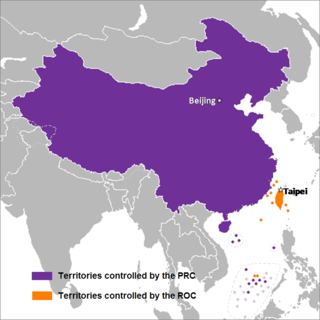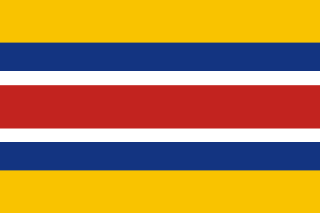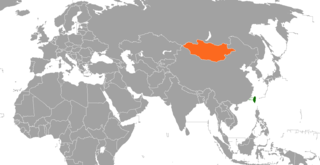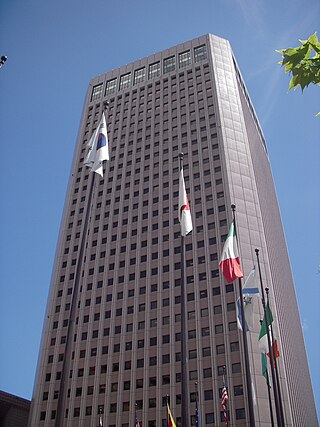
The member states of the United Nations comprise 193 sovereign states. The United Nations (UN) is the world's largest intergovernmental organization. All members have equal representation in the UN General Assembly.

Chinese unification, also known as Cross-Strait unification or Chinese reunification, is the potential unification of territories currently controlled, or claimed, by the People's Republic of China and the Republic of China ("Taiwan") under one political entity, possibly the formation of a political union between the two republics. Together with full Taiwan independence, unification is one of the main proposals to address questions on the political status of Taiwan, which is a central focus of Cross-Strait relations.
The political status of Taiwan or the Taiwan issue is a long-running dispute on the status of Taiwan, currently controlled by the Republic of China (ROC). Originally based in Mainland China, the ROC government retreated to Taiwan in 1949 after the Chinese Communist Party (CCP) won the Chinese Civil War and established the People's Republic of China (PRC) in Mainland China. Since then, the effective jurisdiction of the ROC has been limited to Taiwan, Penghu, Kinmen, Matsu, and smaller islands.

Mengjiang, also known as Mengkiang or the Mongol Border Land, officially referred to as the Mengjiang United Autonomous Government, was an autonomous area in Inner Mongolia, formed in 1939 as a puppet state of the Empire of Japan, then from 1940 being under the nominal sovereignty of the Reorganized National Government of the Republic of China. It consisted of the previously Chinese provinces of Chahar and Suiyuan, corresponding to the central part of modern Inner Mongolia. It has also been called Mongukuo or Mengguguo. The capital was Kalgan, from where it was under the nominal rule of Mongol nobleman Demchugdongrub. The territory returned to Chinese control after the defeat of the Japanese Empire in 1945.
The history of the Republic of China begins after the Qing dynasty in 1912, when the Xinhai Revolution and the formation of the Republic of China put an end to 2,000 years of imperial rule. The Republic experienced many trials and tribulations after its founding which included being dominated by elements as disparate as warlord generals and foreign powers.
China is one of the charter members of the United Nations and is one of five permanent members of its Security Council.

The United Nations General Assembly Resolution 2758 was passed in response to the United Nations General Assembly Resolution 1668 that required any change in China's representation in the UN be determined by a two-thirds vote referring to Article 18 of the UN Charter. The resolution, passed on 25 October 1971, recognized the People's Republic of China as "the only legitimate representative of China to the United Nations" and removed "the representatives of Chiang Kai-shek" from the United Nations.
This article is concerned with the events that preceded World War II in Asia.

The term "Two Chinas" refers to the geopolitical situation where two political entities exist under the name "China".

The Treaty of Friendship and Alliance was a treaty signed by the National Government of the Republic of China and the Government of the Union of Soviet Socialist Republics on 14 August 1945. Soviet and Mongolian troops then occupied Inner Mongolia and Manchuria, after they had seized it from the Japanese during World War II. In a declaration made in connection with the treaty, China accepted the independence of Outer Mongolia within its previous borders and disavowed any Pan-Mongolist intentions of the occupiers if a referendum on the issue was held. Also, the Soviet Union ceased aiding the Chinese Communist Party and the Ili National Army, which were rebelling in Xinjiang. Both nations also agreed upon joint control of the Chinese Eastern Railway and to facilitate its eventual return to full Chinese sovereignty.

At its establishment in 1912, the Republic of China claimed to be the successor state to the entirety of the Qing empire, which included Outer Mongolia. The Republic of China did not recognize Outer Mongolia until 1945; neither country exchanged diplomats between 1946 and 1949. At the end of the Chinese Civil War in 1949, Mongolia recognized the People's Republic of China and the Republic of China retreated to the island of Taiwan. The Republic of China continued to show Mongolia as part of its territory on official maps until 2002 when they recognized Mongolia as an independent country, and informal relations were established between the two sides.
The decolonisation of Asia was the gradual growth of independence movements in Asia, leading ultimately to the retreat of foreign powers and the creation of several nation-states in the region.

The territorial conquests of the Empire of Japan in the Western Pacific Ocean and East Asia began in 1895 with its victory over Qing China in the First Sino-Japanese War. Subsequent victories over the Russian Empire and German Empire expanded Japanese rule to Taiwan, Korea, Micronesia, southern Sakhalin, several concessions in China, and the South Manchuria Railway. In 1931, Japan invaded Manchuria, resulting in the establishment of the puppet state of Manchukuo the following year; thereafter, Japan adopted a policy of founding and supporting puppet states in conquered regions. These conquered territories became the basis for the Greater East Asia Co-Prosperity Sphere in 1940.
National Assembly elections were held between 21 and 23 November 1947 in China. This is the first election of under the newly ratified 1947 Constitution of the Republic of China. Under this constitution, the National Assembly is an authoritative legislature body that holds the power as constitutional convention and presidential electoral college. A total of 2,961 delegates were elected from across the country.

The Republic of China (ROC) or simply China was a sovereign state based in mainland China from 1912 to 1949 prior to its move to Taiwan. It was first established on 1 January 1912, after being proclaimed in the Xinhai Revolution against the Manchu-led Qing dynasty, and lasted until 7 December 1949, after its ruling party Kuomintang (KMT) was defeated by the Chinese Communist Party (CCP) at the de facto end of the Chinese Civil War, which resulted in a retreat of its central government to Taiwan, a territory which it took control of from the Empire of Japan in October 1945 after its surrender in World War II. The Communist-led People's Republic of China (PRC) was established on the mainland upon its official proclamation on 1 October 1949, while the ROC is now based on the island of Taiwan with its capital Taipei, where it retains actual rule over the Taiwan Area with the political status of Taiwan remaining in dispute to this day.

The permanent members of the United Nations Security Council are the five sovereign states to whom the UN Charter of 1945 grants a permanent seat on the UN Security Council: China, France, Russia, the United Kingdom, and the United States.
The administrative divisions of China between 1912 and 1949 were established under the regime of the Republic of China government.

The Republic of China (Taiwan) and the Federative Republic of Brazil do not have official diplomatic relations, as Brazil acknowledges the One-China policy. However, the two nations maintain unofficial diplomatic relations via economic and cultural offices.

The Ulaanbaatar Trade and Economic Representative Office, is the representative office of Mongolia in Taiwan, functioning as a de facto embassy in the absence of diplomatic relations.
The Japan–Russia Secret Agreements were a series of four secret treaties signed between Empire of Japan and Russian Empire after the Russo-Japanese War, in order to secure and recognize the rights of both sides in areas of the East Asia, specifically the Korean Peninsula, Manchuria, and Mongolia. They were signed four times between 30 July 1907 and around 3 July 1916, and were abrogated by the Soviet government after the Russian Revolution in 1917.












